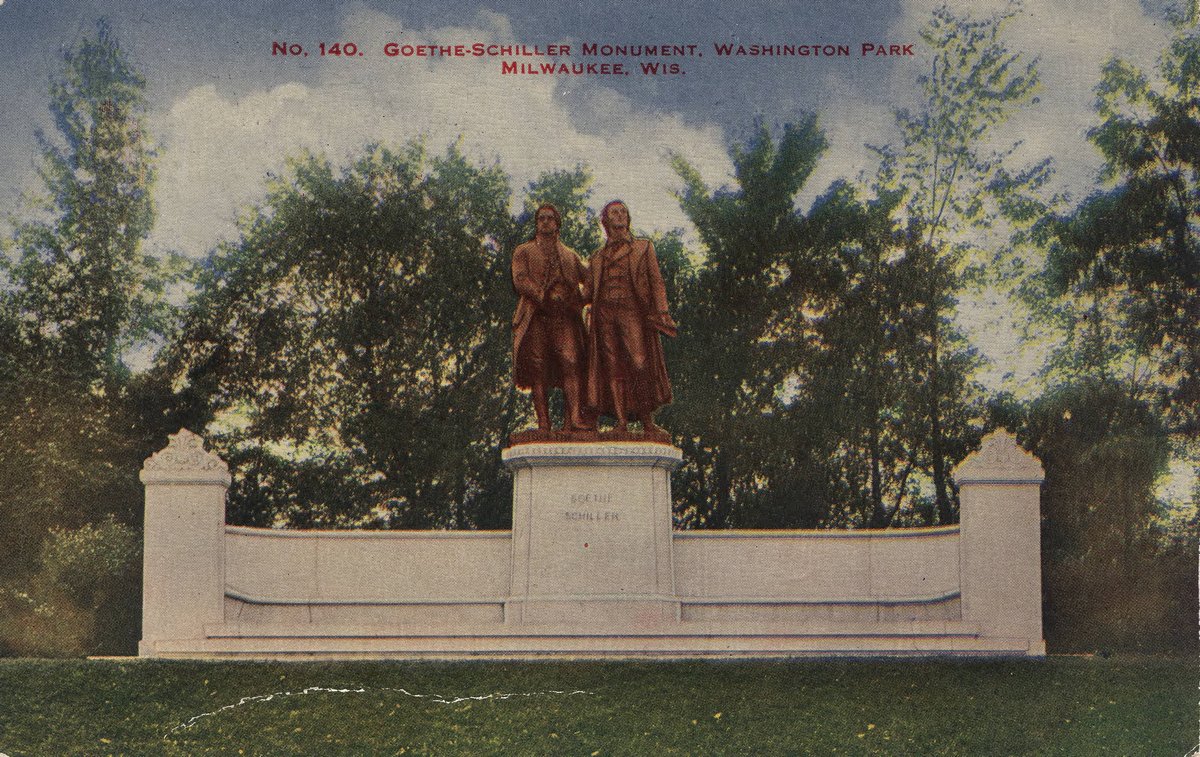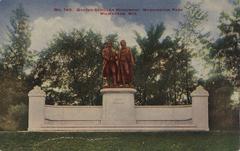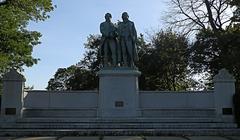
Goethe–Schiller Monument Milwaukee: Visiting Hours, Tickets, and Historical Information
Date: 14/06/2025
Introduction
The Goethe–Schiller Monument in Milwaukee stands as a proud symbol of the city’s German-American heritage and intellectual tradition. Situated in historic Washington Park, this impressive bronze statue commemorates Johann Wolfgang von Goethe and Friedrich Schiller, two of Germany’s most celebrated literary figures. Erected in 1908, the monument honors the enduring friendship and collaboration between these giants of German literature while reflecting Milwaukee’s vibrant immigrant history and cultural identity. Today, the monument remains a focal point for heritage celebrations, community gatherings, and educational programs.
This guide provides a comprehensive overview of the monument’s origins, artistic features, cultural significance, and essential visitor information—including hours, accessibility, nearby attractions, and tips for your visit. Whether you’re a history buff, a literature enthusiast, or a curious traveler, this resource will help you plan a rewarding visit to one of Milwaukee’s most cherished landmarks. For the latest updates, see resources such as the Milwaukee Historical Society, Visit Milwaukee, and Milwaukee County Parks.
History and Origins
Commissioning and Dedication
The Goethe–Schiller Monument in Milwaukee is a direct descendant of the original 1857 monument in Weimar, Germany, sculpted by Ernst Rietschel. As German immigrants established a strong presence in Milwaukee, the city became known as the “German Athens of America.” To celebrate this heritage, over thirty German societies and prominent families—including the Vogels, Brumders, and Nunnemachers—raised $15,000 to commission a replica of Rietschel’s masterpiece (Wikipedia).
Dedicated on June 12, 1908, before a crowd of 35,000, the event featured choral performances, readings of Goethe’s and Schiller’s works, and a Turnverein gymnastics demonstration (Wikipedia). The ceremony was a major cultural event, with speeches delivered in both German and English, and a congratulatory message from German Emperor Wilhelm II.
Artistic and Architectural Features
The monument is a faithful bronze replica of Rietschel’s Weimar original. Goethe and Schiller are depicted side by side, slightly larger than life, standing atop a granite pedestal engraved with their names. Goethe holds a laurel wreath—symbolizing poetic honor—while Schiller holds a scroll, representing literary achievement. Their period attire and expressive postures reflect the neoclassical style, emphasizing intellectual camaraderie and mutual respect. The figures were cast at the Lauchhammer foundry in Germany, using Rietschel’s original molds (Wikimedia Commons).
Unique to the Milwaukee setting are the wide steps and extended stone benches that invite visitors to linger and reflect. A plaque at the base features a quote from Schiller’s “Wallenstein”: “Who dares nothing, need hope for nothing,” underscoring the monument’s message of courage and aspiration (Kiddle).
Cultural Context and Significance
By 1900, nearly one-third of Milwaukee’s residents were of German descent, and German language, customs, and traditions were prominent throughout the city (GAMHOF). The Goethe–Schiller Monument became a powerful symbol of unity among Milwaukee’s diverse German-speaking groups, emphasizing shared intellectual ideals and cultural pride.
During World War I, however, anti-German sentiment led to the suppression of German culture. The monument was covered up, reflecting the tensions of the era (Urban Milwaukee). Despite these challenges, the statue endured and today stands as a testament to reconciliation and the lasting impact of immigrant communities in shaping Milwaukee’s identity.
Visiting the Goethe–Schiller Monument
Location and Setting
The monument is prominently located in Washington Park, near West Vliet Street and North 43rd Street, on Milwaukee’s west side. The park features scenic walking paths, gardens, and proximity to attractions like the Milwaukee County Zoo (Visit Milwaukee). The landscaped setting—with mature trees, seasonal flower beds, and inviting benches—provides a peaceful backdrop for reflection and photography.
Visiting Hours and Admission
- Park Hours: Daily from 6 a.m. to 11 p.m.
- Monument Access: Freely accessible during park hours; no tickets or reservations required.
- Admission: Free of charge to all visitors.
Accessibility and Amenities
- Wheelchair Accessibility: Paved pathways provide full wheelchair access to the monument area.
- Parking: Street and lot parking are available nearby (note possible limitations during events).
- Public Transit: Served by Milwaukee County Transit System (MCTS) bus routes 14 and 21 (MCTS website).
- Restrooms: Public restrooms are available in the park or nearby cafes and public buildings.
- Seating: Benches are available for rest and contemplation.
Guided Tours and Special Events
- Tours: Heritage tours featuring the monument are occasionally offered by the Milwaukee County Historical Society and other local organizations.
- Festivals: The monument is a focal point for German heritage events such as Oktoberfest and German Fest (Milwaukee World Festival). These events often include guided walks, performances, and cultural presentations.
- Community Engagement: The monument serves as an educational resource for schools and cultural groups, and is often included in Milwaukee history tours (GetYourGuide).
Photography and Visitor Etiquette
- Best Light: Early morning and late afternoon provide optimal lighting for photos.
- Etiquette: Please do not climb on the statue or disturb the landscaping. Pets must be leashed and cleaned up after.
- Safety: The area is well-lit and considered safe, but standard urban precautions are always recommended.
Additional Visitor Information
Nearby Attractions
- Milwaukee County Zoo: Family-friendly attraction adjacent to Washington Park.
- Pabst Mansion: Historic home of the famous brewing family, reflecting Milwaukee’s German-American legacy.
- Milwaukee Art Museum & Public Museum: Short drives from the monument, offering wider cultural experiences.
- Washington Heights Community Garden: Adds to the neighborhood’s charm and green space.
Travel Tips
- Weather: Milwaukee’s climate varies by season; winter may bring snow and icy paths.
- Duration: Plan for 15–30 minutes at the monument. Consider combining with other local attractions for a half-day itinerary.
- Language: English is primary, but some German signage reflects the monument’s heritage.
Conservation and Preservation
The monument is maintained by the Milwaukee County Parks Department, with regular inspections and cleaning to prevent corrosion and preserve the artistic details for future generations (Milwaukee County Parks).
Frequently Asked Questions (FAQ)
Q: What are the visiting hours?
A: Washington Park is open daily from 6 a.m. to 11 p.m. The monument is freely accessible during these hours.
Q: Is there an entrance fee or ticket required?
A: No. The monument is free to visit and does not require tickets or reservations.
Q: Is the monument wheelchair accessible?
A: Yes. Paved pathways provide full access for wheelchairs and strollers.
Q: Are guided tours available?
A: Yes, during special events or by arrangement with local heritage organizations. Check Milwaukee County Parks or GetYourGuide for current offerings.
Q: Where can I park?
A: Street and lot parking are available, but may be limited during festivals and events.
Q: Are restrooms available?
A: Restrooms are available in the park and at nearby establishments.
Visuals and Media
- Explore photos of the monument and its surroundings on Wikimedia Commons.
- Use descriptive alt text for accessibility, such as “Goethe–Schiller Monument Milwaukee bronze statue in Washington Park.”
- For interactive maps or virtual tours, refer to the Milwaukee Digital Visitors Map.
Summary and Recommendations
The Goethe–Schiller Monument in Milwaukee is a testament to the city’s German-American roots, artistic heritage, and ongoing commitment to cultural preservation. Its prominent location, neoclassical artistry, and role in community life make it a rewarding destination for visitors of all backgrounds. Take advantage of free access, wheelchair-friendly paths, and its proximity to other attractions for a well-rounded Milwaukee experience.
To enhance your visit, check for seasonal tours and events, utilize digital resources like the Audiala app, and consult official sites for up-to-date information:
Plan your visit today to experience the enduring legacy of Goethe and Schiller—and the vibrant cultural tapestry of Milwaukee.
Sources and Further Reading
- Milwaukee Historical Society
- Visit Milwaukee
- Wikipedia – Goethe–Schiller Monument (Milwaukee)
- GetYourGuide – Schiller Monument
- Milwaukee County Parks – Washington Park

























